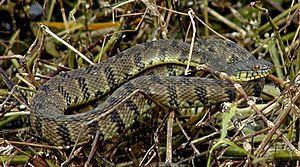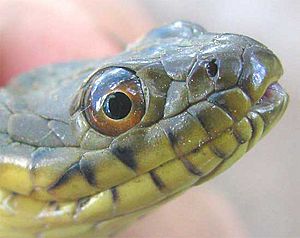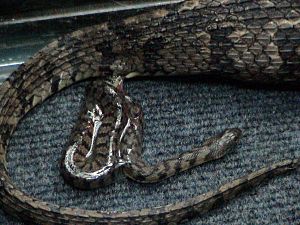Diamondback water snake facts for kids
Quick facts for kids Diamondback water snake |
|
|---|---|
 |
|
| Conservation status | |
| Scientific classification | |
| Genus: |
Nerodia
|
| Species: |
rhombifer
|
| Subspecies | |
|
N. r. blanchardi (Clay, 1938) |
|
| Synonyms | |
|
|
The Nerodia rhombifer, also known as the diamondback water snake, is a snake that is not venomous. You can find it in the central United States and northern Mexico. These snakes are quite common in their natural homes.
Contents
- What Does the Diamondback Water Snake Look Like?
- Where Do Diamondback Water Snakes Live?
- How Do Diamondback Water Snakes Behave?
- Where Can You Find Diamondback Water Snakes?
- How Do Diamondback Water Snakes Have Babies?
- Are Diamondback Water Snakes Endangered?
- Diamondback Water Snakes as Pets
- Cool Facts About the Diamondback Water Snake
- See also
What Does the Diamondback Water Snake Look Like?
The diamondback water snake can be brown, dark brown, or dark olive green. It has a cool, net-like pattern on its back. Each spot in this pattern looks a bit like a diamond.
Along its sides, you might see dark vertical bars and lighter colors. The snake's belly is usually yellow or a lighter brown. It often has black blotches there too. Young snakes are usually lighter, so their patterns stand out more. As they get older, their colors become darker.
Where Do Diamondback Water Snakes Live?
This snake is one of the most common types in the areas where it lives. You will find it close to slow-moving water. This includes places like streams, rivers, ponds, or swamps. They love watery environments.
How Do Diamondback Water Snakes Behave?
When a diamondback water snake is looking for food, it might hang from branches over the water. It dips its head under the water's surface. It waits until it finds a fish or other prey to catch.
These snakes often bask, or warm themselves, on branches above the water. If someone gets too close, the snake will quickly jump into the water. Then it swims away fast. If it feels trapped, it might hiss loudly. It can also flatten its body to look bigger and scarier. It usually only bites if it feels very scared or is being bothered.
Where Can You Find Diamondback Water Snakes?
The diamondback water snake lives in the central United States. It is found along the Mississippi River valley. You can see this snake in many states. These include Texas, Oklahoma, Kansas, Iowa, Louisiana, Arkansas, Missouri, Illinois, Indiana, Tennessee, Mississippi, Georgia, and Alabama. It also lives in northern Mexico. There, it is found in the states of Coahuila, Nuevo León, Tamaulipas, and Veracruz.
How Do Diamondback Water Snakes Have Babies?
Diamondback water snakes are ovoviviparous. This means the mother snake carries her eggs inside her body. The babies hatch from the eggs while still inside her. Then, she gives birth to live young.
These snakes breed in the spring. The female snakes give birth in the late summer or early fall. When they are born, young snakes are about 8 to 10 inches (20 to 25 cm) long.
Are Diamondback Water Snakes Endangered?
No, the diamondback water snake is not an endangered or threatened animal. It is very common in many areas. However, people sometimes kill these snakes out of fear. This often happens because they are mistaken for dangerous snakes. People sometimes confuse them with the cottonmouth or rattlesnakes.
Diamondback Water Snakes as Pets
You can often find diamondback water snakes kept as pets. They might bite when first caught. But with regular handling, they usually become quite calm. In captivity, they enjoy eating fish. Their diet should also include vitamin B1. Larger snakes might also eat small rodents.
Cool Facts About the Diamondback Water Snake
- The first time this snake was described was in 1852. This was done by Edward Hallowell.
- These snakes usually grow to be about 30 to 48 inches (76 to 122 cm) long. This length includes their tail.
- The longest diamondback water snake ever recorded was 69 inches (175 cm) long!
- The skin of the diamondback water snake feels rough. This is because its scales on its back are heavily keeled.
- The snake's bite can be quite painful. This is because it has sharp teeth. These teeth help it hold onto slippery fish.
See also
 In Spanish: Culebra de agua de diamantes para niños
In Spanish: Culebra de agua de diamantes para niños




